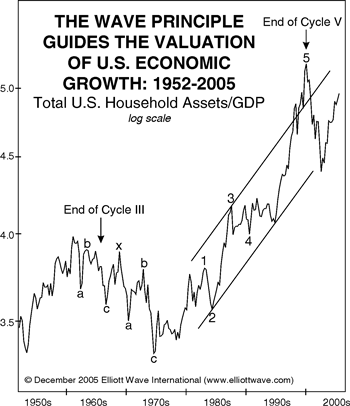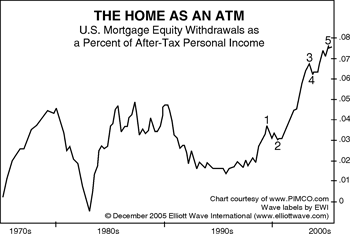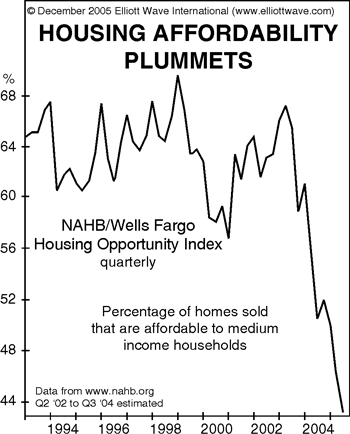As the quote above and various comments in today's issue of The Elliott Wave Financial Forecast note, the reversal into a deflatoinary contraction is a collective shift from an expansive psychology of optimism to an increasingly cautious mindset. Once this conservatism takes hold, it feeds on itself as actions like those of the mortgage lenders discussed at left lead to lower returns and valuations which creates more cautious approaches to the housing market leading to more cutbacks and price slashing and so on. The arrival of this shift in the real estate sector is described in today's EWFF. While real estate is leading the way and it is an integral part of the shift to deflation, it is not the cause of it. The driving force behind the reversal and its presence in real estate, the market for debt and the economy was fully described in the January issue of EWFF. As promised in today's issue, that discussion appears below.
January 2006, EWFF
THE ECONOMY & DEFLATION

One of the built-in ironies of the Wave Principle is that as prices climb in fifth waves the economic “fundamentals” weaken relative to the preceding third wave. But even as this faltering betrays the economy’s eventual reversal, investors place a higher and higher value on the economic performance itself. With an array of charts and comparative data, Chapter 1 of Conquer the Crash illustrates one of history’s classic (not to mention relevant) cases–the dramatic underperformance of the U.S. economy in Cycle wave V (19740-2000) versus Cycle wave III (1942-1966). The chart above divides the Federal Reserve’s figure for total assets in U.S. households by GDP to create a quarterly snapshot of the valuation that investors have placed on the productive capacity of the U.S. economy over the past half-century. Study the chart closely. It reveals much about the economy’s prospects in the months and years ahead. First and foremost, it shows the dramatic difference between valuations at the end of Cycle III versus Cycle V. Notice that in Cycle III, when Supercycle wave (V) was still many years from completion, the highest valuation did not come at the peak in 1966, but in 1961 when the value of U.S. assets were about 4 times GDP. They approached that level but did not exceed it at the Cycle III peak in 1966 and in late 1968 when the Dow double-topped. After bottoming with the S&P in October 1974, the ratio began a long ascent to a substantial new peak in which assets were valued at 5.18 times GDP, 30% higher than Cycle III’s peak. The high was coincident with the S&P’s March 2000 all-time peak. Given the weakening state of the fundamentals depicted in Conquer the Crash, Cycle V certainly stayed true to the Wave Principle’s knack for pushing things to extremes in a fifth wave.
The count on the chart shows the guiding hand behind the great advance. Notice the clearly impulsive form of the rise from 1974 to 2000. Then came the largest drop on the entire graph, in the first wave of the bear market. As of September 30, the ratio had recovered 76% of its March 2000-March 2003 decline, close to a Fibonacci 78.6% (), the maximum common retracement. The current rally in stocks may well push the rebound to 78.6% of the preceding decline. In the late 1990s, we argued that the persistent deceleration of the U.S. economy was “vitally important” because it “portends a major reversal.” This pattern says that it is now of paramount importance because the ratio is nearly out of room to run higher and must reverse. The result should be a stunning economic collapse and accompanying re-valuation that takes the price of U.S. assets back toward—and probably below—the 3.3 times GDP level of 1974.
Not one economist in Business Week’s field of 54 is predicting a down quarter in 2006. The reason is that the economy continues to grow. Setting aside for a moment the fact that the current trend per se is no basis for a forecast, we would also point out that the reason the economy is growing is that consumers have been able and more than willing to supplement their weakening earnings power with higher and higher levels of debt. In dollar terms, consumer, industrial and mortgage debt continues to rise. In real terms, however, the level of consumer and industrial loans is actually below its peak in 2002. The left chart below shows how the October 2000 issue of EWFF used the Wave Principle to anticipate this reversal. It is of critical importance because, as Conquer the Crash notes, the change to deflation is triggered by a retreat among lenders and borrowers:
As creditors become more conservative, they slow their lending. As debtors and potential debtors become more conservative they borrow less or not at all.

Of course, year-end figures for total debt will again show a rise in 2005 because the third major category, mortgages, continued to boom. For the year, households borrowed the equity in their homes at a record rate. In fact, research from Paul Kasriel of Northern Trust shows that after falling steadily from 1995 to 2001, household liabilities as a percentage of total assets rose to 18.32% in March 2003, due to record levels of home equity withdrawals through mortgage refinancings. After a brief initial drop with the 2003 rally in stocks and real estate, households mortgaged new home purchases and existing equity in their homes so aggressively that their total liabilities hit 18.23% of total assets, close to the record level of March 2003. So, the average household balance sheet has barely benefited from the countertrend rally in stocks and real estate. But if the debt burden has been rising since the beginning of the bull market, why should it reverse now? There is no “fundamental” reason, but there are some profoundly bearish technical ones.

This chart shows net home equity withdrawals as a percent of after-tax personal income. Here again, the five-wave rise speaks volumes, especially in association with the extremely bearish patterns shown for real estate in recent months (see page 8 of the July and September issues).
As the story about the drop in the Boston housing market on page 1 of latest issue of The Elliott Wave Theorist attests, evidence of a real estate washout is already starting to come in. An insurance agent/subscriber reports that he sees more signs of exhaustion on a daily basis: “I’ve seen people using their home as an ATM machine. We have people calling us who filed bankruptcy within the past two years wanting a home insurance policy. We refer them to a State Farm agent. Currently, this agency has a record-setting number of people ‘pending cancellation.’ We are increasingly receiving notices from mortgage companies telling us a home is vacant or going through foreclosure. Things are not pretty and all this taking place with the DJIA at 10,000+.”

This chart of housing affordability shows the shaky foundation on which the final phase of the credit bubble rests. Just since 2002, the percentage of homes that families earning the median income can afford has declined from more than 65% to 43%. Every major real estate bust begins with a sudden realization that lending standards have slipped. Our discussions of lax mortgage underwriting standards certainly attests to similar conditions in the present case (see pages 7 and 8 of the September issue). In fact, given the sluggish economy and the total lack of collateral required by many lenders, we conclude that the latest real estate bubble has resulted from the easiest money environment in history. In classic bubble-quashing fashion, regulators are now moving en masse to “correct” the situation with regulatory initiatives designed to rein in slack lending practices. A few days before Christmas, papers all over the country reported, “The Federal Reserve and other bank regulators said interest-only and other nontraditional mortgages pose a threat to the financial system and urged the nation’s banks to tighten lending standards.” The Federal Reserve, Office of the Comptroller of the Currency, U.S. Treasury and FDIC “unveiled long-awaited guidance for interest-only and option adjustable-rate mortgages. While the notice doesn’t carry the force of a federal regulation, it could cause lenders to become ‘a little more conservative.’” The use of the word “conservative” confirms that the shift to deflation is probably starting. There won’t be anything little about the consequences.
Home sales are falling across the board now, but the surest sign of an oncoming collapse for real estate is that even those who view its recent performance as a bubble contend that there will be no wholesale decline. “Virtually no investors expect sudden burst of housing bubble,” says the headline of a UBS/Gallup Poll of investor attitudes: “Just 1% of all investors expect housing prices next year to exhibit a rapid decline.” This sentiment is bearish for real estate prices, and, even more important, a beacon to a deflationary depression.
The Era of Consumer Satisfaction
Another key change is visible in the behavior of consumers. There is evidence that they are curbing their voracious appetite for goods. In October, U.S. vehicle sales declined to 14.7 million units (annualized), the lowest level in seven years. The plunge produced a record drop of $7.2 billion in consumer credit, its sharpest one-month fall in history. Value consciousness was clearly evident throughout the holidays as furious demand for sale items triggered mini-riots in several cities. In New York, “fashion piranhas swarmed H&M stores clawing and scratching for a piece of limited edition clothing. ‘Back off my dress bitch,’ screamed one woman.” In Baltimore, “angry women” pushed, shoved and cursed “their way toward a chance at high-end purses in a heavily advertised sale. The phenomenon of bargain shoppers rage doesn’t just happen to women either. Men experience it. People in England, Bangledesh and Saudi Arabia have seen recent cases of it, too.” Shoppers looking for early season Christmas specials “stormed the doors in a mad rush” at a Wal-Mart in Grand Rapids, Mich., were pepper sprayed in Beaumont, Tex. and got into fist fights in Orlando, Fla.
The experience of the U.S. auto industry demonstrates that slashing prices in this environment can be a tricky business. Since mid-2004 when they started to offer aggressive rebates, car makers are finding out that once consumers get a taste of lower prices, they quickly come to expect them. When the big three U.S. automakers tried to remove rebates and employee pricing in August, sales evaporated so fast that they had to be reinstated. But even with the price cuts, sales are still down from 1.1 million in July to a little over 600,000 in October and November. General retailers have cannibalized future sales, too. Remember when they used to wait until after Christmas to put merchandise on sale? This year, sales started the day after Thanksgiving. Macy’s had to cut prices by 50% weeks before Christmas to “rescue” the season. Many garment stores also stole from future demand by pushing spring fashions in December. The next step will be an outright—and probably dramatic—decline in consumer demand. Virtually no one believes it can happen, but these charts suggest otherwise. As deflation intensifies, consumers realize that the best approach is to put off purchases altogether because the longer they wait, the cheaper cars and other items will become. The key signal of this change will be the bursting of the credit bubble; the junk bond market’s renewed retreat and the completion of five-wave rallies in the debt charts shown earlier foreshadow exactly this event. As the money destruction in the form of unpaid debt intensifies, consumers with cash will be extremely reluctant to part with it. Those without it will find that they can’t borrow their way out of trouble the way that they did in 2000 because of the new conservatism among lenders. Without the juice that kept consumers spending freely back in the bull market and through the early phases of the bear, a 25-year spending binge will be brought to a quick halt. The result will be the depression forecast in Conquer the Crash.
|
